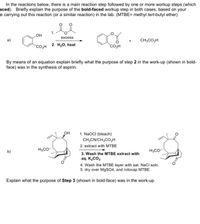
Chemistry
10th Edition
ISBN: 9781305957404
Author: Steven S. Zumdahl, Susan A. Zumdahl, Donald J. DeCoste
Publisher: Cengage Learning
expand_more
expand_more
format_list_bulleted
Concept explainers
Question

Transcribed Image Text:In the reactions below, there is a main reaction step followed by one or more workup steps (which
aced). Briefly explain the purpose of the bold-faced workup step in both cases, based on your
e carrying out this reaction (or a similar reaction) in the lab. (MTBE= methyl tert-butyl ether)
но
excess
CH;CO,H
CO,H
2. H20, heat
co,H
By means of an equation explain briefly what the purpose of step 2 in the work-up (shown in bold-
face) was in the synthesis of aspirin.
он
1. NaOCI (bleach)
CH,CN/CH;CO2H
2. extract with MTBE
H3CO"
H,CO
b)
3. Wash the MTBE extract with
aq. K,Co,
4. Wash the MTBE layer with sat. NaCl soln.
5. dry over MgSO4, and rotovap MTBE
Explain what the purpose of Step 3 (shown in bold-face) was in the work-up.
Expert Solution
This question has been solved!
Explore an expertly crafted, step-by-step solution for a thorough understanding of key concepts.
Step by stepSolved in 2 steps

Knowledge Booster
Learn more about
Need a deep-dive on the concept behind this application? Look no further. Learn more about this topic, chemistry and related others by exploring similar questions and additional content below.Similar questions
- Predict the products when 1-propanol is heated in the presence of H+. Include all hydrogen atoms in your structure. Show both the organic product and the inorganic product formed in this reaction. Select Draw Rings More Erase 1-propanol H₂SO₂ catalyst C २ Qarrow_forwardA student performed the reaction below with reagents A, B, and C. However, the student did not explain the ORDER of steps in the laboratory write-up. Please order the steps (note, reagents may be used more than once). ?? .Co,H Br Br 1 equivalent NaOEt H3o+/ Heat A В O C-B-A оВ-А-С O The student's notes were incomplete - these reagents don't work. оВ -А-В-Сarrow_forward16. Show all work please!arrow_forward
- Write the products and develope the reaction mechanism.arrow_forwardproduct obtained and draw the mechanism of its formation. Draw all missing reactants and/or products in the appropriate boxes by placing atoms on the canvas and connecting them with bonds. Add charges w arrows should start on the electron(s) of an atom or a bond and should end on an atom, bond, or location where a new bond should be created. DDC H EXP CONT ? L W OH H―CI: A ΔΟ CE CI :CI: H―CIAarrow_forwardBr Showth the mechanism of that reaction Br Br Br Br Br 20 AcOW/M₂0arrow_forward
- 4. Explain why the rate of formation of 1-azidopropane is different depending on which halopropane (X = F, Cl, Br, I) is used. Explain which halopropane will react fastest? ~X X = F, Cl, Br, I NaN №3 1-azidopropanearrow_forwardChoose the LEAST favorable reaction. If images/letters are not displaying correctly, try maximizing your screen. E+ E+ E* LE HO, `OH HO, `OH E REACTION A REACTION B REACTION C O REACTIONA O REACTION B O REACTION C O ALL ARE EQUALLY FAVORABLE CANNOT BE DETEREMINED FROM THE INFORMATION PROVIDEDarrow_forwardDraw the mechanism for the equilibrium illustrated below. What is the process called? Is the Keq >1, <1, =1 for this reaction as illustrated. Is the equilibrium direction dictated by thermodynamics or kinetics? Explain your rationale in detail.arrow_forward
arrow_back_ios
arrow_forward_ios
Recommended textbooks for you
 ChemistryChemistryISBN:9781305957404Author:Steven S. Zumdahl, Susan A. Zumdahl, Donald J. DeCostePublisher:Cengage Learning
ChemistryChemistryISBN:9781305957404Author:Steven S. Zumdahl, Susan A. Zumdahl, Donald J. DeCostePublisher:Cengage Learning ChemistryChemistryISBN:9781259911156Author:Raymond Chang Dr., Jason Overby ProfessorPublisher:McGraw-Hill Education
ChemistryChemistryISBN:9781259911156Author:Raymond Chang Dr., Jason Overby ProfessorPublisher:McGraw-Hill Education Principles of Instrumental AnalysisChemistryISBN:9781305577213Author:Douglas A. Skoog, F. James Holler, Stanley R. CrouchPublisher:Cengage Learning
Principles of Instrumental AnalysisChemistryISBN:9781305577213Author:Douglas A. Skoog, F. James Holler, Stanley R. CrouchPublisher:Cengage Learning Organic ChemistryChemistryISBN:9780078021558Author:Janice Gorzynski Smith Dr.Publisher:McGraw-Hill Education
Organic ChemistryChemistryISBN:9780078021558Author:Janice Gorzynski Smith Dr.Publisher:McGraw-Hill Education Chemistry: Principles and ReactionsChemistryISBN:9781305079373Author:William L. Masterton, Cecile N. HurleyPublisher:Cengage Learning
Chemistry: Principles and ReactionsChemistryISBN:9781305079373Author:William L. Masterton, Cecile N. HurleyPublisher:Cengage Learning Elementary Principles of Chemical Processes, Bind...ChemistryISBN:9781118431221Author:Richard M. Felder, Ronald W. Rousseau, Lisa G. BullardPublisher:WILEY
Elementary Principles of Chemical Processes, Bind...ChemistryISBN:9781118431221Author:Richard M. Felder, Ronald W. Rousseau, Lisa G. BullardPublisher:WILEY

Chemistry
Chemistry
ISBN:9781305957404
Author:Steven S. Zumdahl, Susan A. Zumdahl, Donald J. DeCoste
Publisher:Cengage Learning

Chemistry
Chemistry
ISBN:9781259911156
Author:Raymond Chang Dr., Jason Overby Professor
Publisher:McGraw-Hill Education

Principles of Instrumental Analysis
Chemistry
ISBN:9781305577213
Author:Douglas A. Skoog, F. James Holler, Stanley R. Crouch
Publisher:Cengage Learning

Organic Chemistry
Chemistry
ISBN:9780078021558
Author:Janice Gorzynski Smith Dr.
Publisher:McGraw-Hill Education

Chemistry: Principles and Reactions
Chemistry
ISBN:9781305079373
Author:William L. Masterton, Cecile N. Hurley
Publisher:Cengage Learning

Elementary Principles of Chemical Processes, Bind...
Chemistry
ISBN:9781118431221
Author:Richard M. Felder, Ronald W. Rousseau, Lisa G. Bullard
Publisher:WILEY